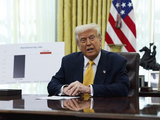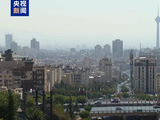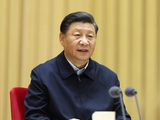U.S. Tariffs; Middle East Tensions; Xinjiang Celebrations; TikTok Deal; Russian Bombers: A Global Geopolitical and Economic Overview

U.S. Tariff Announcements: Diverse Perspectives and Economic Implications
The recent announcements of new U.S. tariffs by President Trump have been covered by various publications, each offering distinct narratives and insights into the potential implications of these policies. Sina reports that starting October 1, the U.S. will impose significant tariffs on a range of imported goods, including a 50% tariff on kitchen cabinets and related building materials, 30% on imported furniture, and a substantial 100% on patented and branded pharmaceuticals. Additionally, all imported heavy trucks will face a 25% tariff. The publication highlights the potential for increased consumer costs as these tariffs could lead to higher prices on imports from the EU, which may ultimately be borne by American consumers.
In another article from United Daily News, the focus is on the broader strategy behind these tariffs, which aim to bolster domestic industries by discouraging imports. The article underscores Trump's emphasis on protecting American manufacturers, especially in the heavy truck sector, from what he perceives as unfair foreign competition. The tariffs are portrayed as a strategic move to incentivize the establishment of manufacturing facilities within the U.S., particularly for pharmaceutical companies.
These developments indicate a significant shift in U.S. trade policy, with the administration leveraging tariffs as a tool to strengthen domestic production and reduce dependency on foreign imports. While the intention appears to be economic protectionism, the potential repercussions include strained relations with trade partners and increased costs for consumers. The varied coverage from different sources highlights the complexity and potential risks associated with these new tariffs, with some experts predicting a slowdown in the U.S. economy and rising inflation as key concerns.
Overall, the narrative across publications suggests a strategic yet contentious approach by the U.S. administration, where the intention is to prioritize national economic interests albeit with significant global trade implications.
Diplomatic Tensions and Military Actions: A Global Overview
Recent events highlight the ongoing tensions in the Middle East and the complex geopolitical dynamics involving Iran and Israel. Sina News reports on Iranian President Ebrahim Raisi's declaration at the United Nations General Assembly, emphasizing Iran's willingness to resolve nuclear issues through diplomacy rather than pursuing nuclear weapon development. Raisi reiterated Iran's readiness to accept nuclear inspections under international law, blaming current tensions on those who violated agreements like the Iran nuclear deal.
Meanwhile, tensions between Israel and Palestine continue to escalate, as another Sina article details a large-scale Israeli airstrike in Gaza, resulting in significant casualties. U.S. President Donald Trump firmly stated he would not allow Israel to annex the West Bank, advocating for peace agreements concerning the Gaza issue. The article also notes U.S. Defense Secretary Lloyd Austin's order for an emergency gathering of military leaders, though the reasons remain undisclosed.
CCTV News adds another dimension, with European Union Council President Charles Michel advocating for a "two-state solution" as the sole path to peace between Israel and Palestine. Michel's remarks at the UN General Assembly underline the EU's commitment to counter-terrorism and ensure security and dignity for both nations.
Liberty Times echoes Trump's stance, emphasizing his pledge to prevent the annexation of the West Bank by Israel. This statement comes amidst Israeli Prime Minister Benjamin Netanyahu's visit to the UN, where he is expected to speak against Palestinian statehood and the recent international recognition of Palestine.
These developments indicate a complex web of diplomatic and military actions shaping the Middle East. While Iran seeks diplomatic resolutions, Israel's military actions continue to provoke international scrutiny. The U.S. and EU's calls for peace underscore a broader desire for stability, though achieving it remains fraught with challenges.
Celebrating Xinjiang: A Grand Display of Unity and Progress
Recent events highlight the significant celebrations marking the 70th anniversary of the Xinjiang Uyghur Autonomous Region's establishment. Various news outlets, including Sina and CCTV, provide extensive coverage of Chinese President Xi Jinping's visit to Xinjiang, underscoring the region's development and unity under the Communist Party's leadership.
Sina's article emphasizes the strategic importance of Xinjiang in China's national policies, noting Xi's call for the region to fully implement the Party's governance strategies. The narrative is rich with symbolic language, portraying Xinjiang as a vital component of China's broader developmental goals, with Xi articulating a vision of a united and thriving modern socialist Xinjiang.
Meanwhile, CCTV highlights the cultural and ethnic unity during Xi's visit, with vivid descriptions of the warm welcomes and cultural exchanges. The coverage aims to project an image of harmony and progress, illustrating how the Party's policies have transformed Xinjiang into a region of stability and prosperity.
In contrast, another Sina article focuses on the vibrant cultural celebrations, including performances and exhibitions that celebrate Xinjiang's ethnic diversity and historical achievements. This piece aims to convey a sense of pride and continuity in the region's development.
Overall, these developments indicate a concerted effort by Chinese media to portray Xinjiang as a success story of economic growth and ethnic unity. While the narratives across different outlets vary slightly in focus—ranging from strategic importance to cultural richness—they collectively emphasize the themes of unity, progress, and the central government's pivotal role in steering Xinjiang's future.
Analyzing the U.S. TikTok Business Deal Narratives
Recent events show that TikTok has been a focal point of discussion regarding its business operations in the United States. United Daily News reports on a significant development where TikTok is valued at $140 billion, highlighting the approval of its business transaction in the U.S. The article briefly mentions other unrelated stories, indicating a mix of content that might not directly pertain to the main topic.
Meanwhile, Sina provides a more focused examination of the new U.S. strategy regarding TikTok. It details how joint venture companies will be responsible solely for data security, transitioning from a 'cloud in Guizhou' to a 'cloud in Texas' approach. This shift underscores a strategic pivot in handling data security concerns, which has been a major sticking point in U.S.-China tech relations.
These developments indicate a concerted effort by TikTok to comply with U.S. regulations while maintaining its vast user base. The news highlights the ongoing geopolitical tensions and the economic maneuvering required to operate within them. While United Daily News provides a broader context with diverse topics, Sina zeroes in on the technical and strategic changes in TikTok's U.S. operations, reflecting different editorial focuses in their coverage.
Russian Strategic Bombers and U.S. Interceptions: A Geopolitical Dance Over International Waters
Recent events highlight the strategic maneuvers of Russian bombers and the corresponding actions of the U.S. military over international waters. According to CCTV, multiple Russian Tu-95MS strategic bombers conducted extensive 14-hour flights over the White Sea and the Sea of Okhotsk. This mission involved in-flight refueling and was escorted by Su-35 and Su-30SM fighter jets. Notably, the U.S. military intercepted these aircraft as they entered the Alaskan Air Defense Identification Zone, although the U.S. clarified that it did not consider these routine flights as acts of aggression.
These developments indicate a pattern of strategic signaling between the two military powers. The second article from CCTV reaffirms the details of the Russian military's adherence to international airspace regulations during these flights, emphasizing the planned nature of the operations over the Barents Sea and the Sea of Okhotsk. Both articles underscore the presence of foreign fighter escorts at certain stages, reflecting a broader geopolitical choreography.
The news highlights the contrasting narratives between Russian and U.S. military activities. While the U.S. focuses on the frequency and monitoring of these flights, as evidenced by nine such reports this year, Russia emphasizes compliance with international norms, possibly to project an image of legitimacy and routine in its military exercises. The coverage by CCTV, linked to Chinese state media, appears to present a balanced account, perhaps aiming to maintain neutrality while showcasing the strategic prowess of its ally, Russia.



